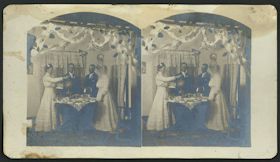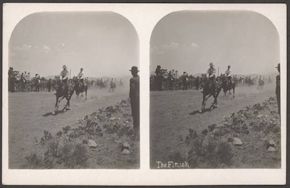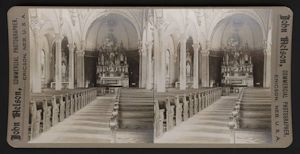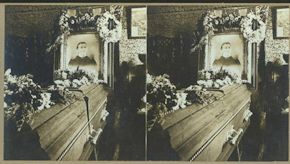What did people use to do for entertainment years ago? What did they do before 3-D movies and 3-D glasses? Well, one form of entertainment from the mid-1800s through the early 1900s (and popping up in the 1950s and 60s again) was stereographs and stereoscopes. Stereographs are two pictures printed on one card which, when viewed through a stereoscope, would provide one image with the illusion of depth.

Double the pleasure, double the fun. Many stereographs were sold in sets—some showing exotic lands and peoples, others showing everyday sights and activities in small town America. The image to the right, “
Double wedding” (
Nebraska State Historical Society Collection), shows two couples celebrating their wedding day. In many of the stereographs, as in this one, the two pictures appear to be duplicates.


Sometimes, though, the pictures were cropped slightly on one side or the other as can be seen at the left in “
The Finish” (
Nebraska State Historical Society Collection), where the not as much of the man at the right in the right image shows as in the image on the left. Other times, the photographer would shift the camera slightly to take a second photograph. That might be the case in the picture to the right of “
Interior of church and altar in Greeley Centre, Nebraska” (
Nebraska State Historical Society Collection)—you do need to look closely to see the slight shift in angle between the two images..


Anything might have been considered fair game as subject matter for stereographs. For example, at the right is a winter scene of the home of a Fremont, Nebraska, resident,
Robert S. Somers (
Keene Memorial Library Collection) and at the left a “
Funeral casket” (
Nebraska State Historical Society Collection). Check out
other stereographs in
Nebraska Memories which include the interiors of stores and homes, farming activities, commercial and public buildings, Native Americans, and Missouri River flooding.
Visit
Nebraska Memories to search for or browse through many more historical images digitized from photographs, negatives, postcards, maps, lantern slides, books and other materials.
Nebraska Memories is a cooperative project to digitize Nebraska-related historical and cultural heritage materials and make them available to researchers of all ages via the Internet. Nebraska Memories is brought to you by the Nebraska Library Commission. If your institution is interested in participating in Nebraska Memories, see
http://nlc.nebraska.gov/nebraskamemories/participation.aspx for more information, or contact
Beth Goble, Historical Projects Librarian, or
Devra Dragos, Technology & Access Services Director.
 Double the pleasure, double the fun. Many stereographs were sold in sets—some showing exotic lands and peoples, others showing everyday sights and activities in small town America. The image to the right, “Double wedding” (Nebraska State Historical Society Collection), shows two couples celebrating their wedding day. In many of the stereographs, as in this one, the two pictures appear to be duplicates.
Double the pleasure, double the fun. Many stereographs were sold in sets—some showing exotic lands and peoples, others showing everyday sights and activities in small town America. The image to the right, “Double wedding” (Nebraska State Historical Society Collection), shows two couples celebrating their wedding day. In many of the stereographs, as in this one, the two pictures appear to be duplicates.

 Sometimes, though, the pictures were cropped slightly on one side or the other as can be seen at the left in “The Finish” (Nebraska State Historical Society Collection), where the not as much of the man at the right in the right image shows as in the image on the left. Other times, the photographer would shift the camera slightly to take a second photograph. That might be the case in the picture to the right of “Interior of church and altar in Greeley Centre, Nebraska” (Nebraska State Historical Society Collection)—you do need to look closely to see the slight shift in angle between the two images..
Sometimes, though, the pictures were cropped slightly on one side or the other as can be seen at the left in “The Finish” (Nebraska State Historical Society Collection), where the not as much of the man at the right in the right image shows as in the image on the left. Other times, the photographer would shift the camera slightly to take a second photograph. That might be the case in the picture to the right of “Interior of church and altar in Greeley Centre, Nebraska” (Nebraska State Historical Society Collection)—you do need to look closely to see the slight shift in angle between the two images..

 Anything might have been considered fair game as subject matter for stereographs. For example, at the right is a winter scene of the home of a Fremont, Nebraska, resident, Robert S. Somers (Keene Memorial Library Collection) and at the left a “Funeral casket” (Nebraska State Historical Society Collection). Check out other stereographs in Nebraska Memories which include the interiors of stores and homes, farming activities, commercial and public buildings, Native Americans, and Missouri River flooding.
Visit Nebraska Memories to search for or browse through many more historical images digitized from photographs, negatives, postcards, maps, lantern slides, books and other materials.
Nebraska Memories is a cooperative project to digitize Nebraska-related historical and cultural heritage materials and make them available to researchers of all ages via the Internet. Nebraska Memories is brought to you by the Nebraska Library Commission. If your institution is interested in participating in Nebraska Memories, see http://nlc.nebraska.gov/nebraskamemories/participation.aspx for more information, or contact Beth Goble, Historical Projects Librarian, or Devra Dragos, Technology & Access Services Director.
Anything might have been considered fair game as subject matter for stereographs. For example, at the right is a winter scene of the home of a Fremont, Nebraska, resident, Robert S. Somers (Keene Memorial Library Collection) and at the left a “Funeral casket” (Nebraska State Historical Society Collection). Check out other stereographs in Nebraska Memories which include the interiors of stores and homes, farming activities, commercial and public buildings, Native Americans, and Missouri River flooding.
Visit Nebraska Memories to search for or browse through many more historical images digitized from photographs, negatives, postcards, maps, lantern slides, books and other materials.
Nebraska Memories is a cooperative project to digitize Nebraska-related historical and cultural heritage materials and make them available to researchers of all ages via the Internet. Nebraska Memories is brought to you by the Nebraska Library Commission. If your institution is interested in participating in Nebraska Memories, see http://nlc.nebraska.gov/nebraskamemories/participation.aspx for more information, or contact Beth Goble, Historical Projects Librarian, or Devra Dragos, Technology & Access Services Director. 
